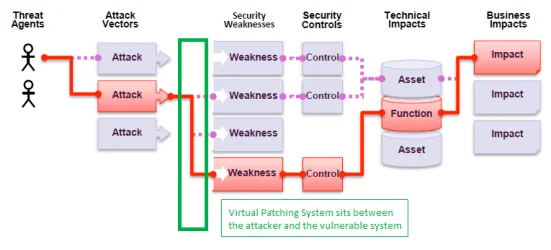- September 24, 2022
- Posted by: admin
- Categories: IT Security, Virtual Patching
What is Virtual Patching?
Virtual patching is a safety mechanism against attacks that exploit known and unknown vulnerabilities. It works by implementing different layers of security policies and rules that prevent and intercept an exploit from taking network paths to and from a vulnerability. The virtual patching works once the security enforcement layer analyses transactions and intercepts attacks in transit, therefore the malicious traffic never gets to the web application. The impact of virtual patching is that without updating the source code, it prevents an exploit from occurring.
It is the rapid development and short-term implementation of a security policy. As a result, the organization would get more time to evaluate the risks associated with the vulnerability in their environment and develop a mitigation strategy.
Virtual patching is all about Risk Reduction. The business owner’s needs have to be understood while gaining the advantage of shortening the time-to-fix metric. Automated patch creation comes into play as the number of vulnerabilities grows. When you identify a vulnerability using automated tools and the corresponding report in an XML format is accessible, it is viable to leverage automated processes to auto-convert the data related to the vulnerability into virtual patches for security systems. WAF products like Prophaze can import XML report data and automatically adjust their protection profiles.
Merits of Virtual Patching
> It reduces the cost of emergency patching.
> It gives protection for mission-critical components that might not be taken offline.
> It is a scalable solution as it needs to be installed in a few locations, rather than on all of the hosts in a network.
> Since the libraries and support code files are not altered, a virtual patch is less likely to produce conflicts in the system.
> It reduces risk until an effective patch is released by the application vendor or while a patch is being tested and applied.
> Even though a vulnerability occurs in between scheduled patch releases, virtual patching helps the organizations to maintain their normal patching cycles without affecting the operations
Various tools are used to achieve Deep Security virtual patching. It includes:
> Web Application Firewall (WAF)
> Intrusion Prevention System (IPS)
> Web server plugin
> Application layer filter
The WAF provides the most sustainable solution for virtual patching. WAF works well in securing your websites and applications. It includes the following features:
Robust HTTP and HTML Parsing
Protocol Analysis
Anti-Evasion Capabilities
Rules instead of Signatures
Security measure compromise
Critical Data Exposure
Network and System Compromise
Reputational Loss
Financial Loss
Why do you need Virtual Patching for your applications & websites?
> It’s scalable as managed web application firewalls can deploy patches to a network of sites at the same time.
> It reduces the risk while the developer of a plugin/component releases the fix.
> Less risk for conflicts compared to when the code is manually patched.
> It provides protection to all sites almost immediately after discovery.
> Reduces time and money from remediation or from manual code patches.

